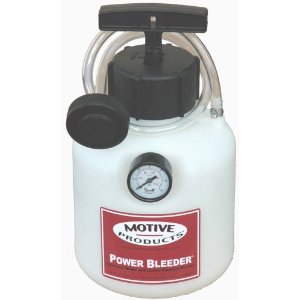630.360.2548

Bleeding your brakes - Motive Power Bleeder
WARNING: Hydraulic fluid is hazardous. Read and follow fluid manufacturer's warnings. Hydraulic fluid is corrosive and may damage automobile paint or other surfaces. If fluid spills, flush with water immediately. Always wear safety goggles when working with hydraulic fluid.
 DIRECTIONS: Use your Power Bleeder only as directed. Read these directions completely before starting. The Power Bleeder is intended for use only by individuals experienced with bleeding and servicing hydraulic systems. If you are unsure about your ability or experience, consult a trained professional. Always follow vehicle manufacturers' directions when bleeding hydraulic systems.
DIRECTIONS: Use your Power Bleeder only as directed. Read these directions completely before starting. The Power Bleeder is intended for use only by individuals experienced with bleeding and servicing hydraulic systems. If you are unsure about your ability or experience, consult a trained professional. Always follow vehicle manufacturers' directions when bleeding hydraulic systems.
1. Ensure that Power Bleeder is clean and free of debris, old hydraulic fluid, or any cleaners or solvents.
2. Remove hydraulic fluid reservoir cap from vehicle. If old fluid is excessively dirty, siphon it off and refill reservoir with fresh fluid. Do not pump excessively dirty fluid through hydraulic system.
3. Firmly attach Power Bleeder cap to the fluid reservoir, ensuring that gasket seats properly and is not worn or cracked.
4. Tighten pump cap onto empty Power Bleeder and pressurize to recommended operating pressure as per repair manual psi. Check for leaks at fluid reservoir and at Power Bleeder fluid hose connections. If reservoir cap or hose connections are leaking, release accumulated pressure in Power Bleeder by gently unscrewing the pump cap. Never remove reservoir cap before depressurizing Power Bleeder tank. Reattach Power Bleeder reservoir cap or tighten hose connections and once again pump tank to 10 psi and check for leaks.
5. If no leaks are found, unscrew pump cap and add up to 2 quarts of new hydraulic fluid from a sealed container. Use only the type of hydraulic fluid recommended for your vehicle.
6. Tighten pump cap. Pressurize Power Bleeder to level recommended in vehicle service manual. Do not exceed 20 psi. Higher pressures may damage your vehicle's hydraulic system and could result in serious injury.
7. Determine proper brake bleeding sequence from your vehicle service manual. Attach bleed tube to bleed valve at the first cylinder to be bled; place open end in a suitable fluid receptacle. Open bleed valve; bleed until fluid runs clear and free of bubbles. Tighten bleed valve to the torque specified in your service manual.
8. Repeat on each bleed valve. Pump additional pressure into Power Bleeder if necessary.
9. If fluid remains in the Power Bleeder tank when through: tip the tank away from fluid pick-up tube and open bleed valve closest to the master cylinder. Allow air to flow into fluid reservoir until fluid level falls just to the maximum fill level on your reservoir. Close the bleed valve and tighten to specified torque.
10. When complete, release pressure by slowly loosening pump cap. Remove the cap from fluid reservoir, taking care to avoid spilling any fluid that remains in the tube.
11. Replace fluid reservoir cap on your vehicle, checking that fluid level is at the maximum level indicated on reservoir.
12. Before driving car, carefully check for leaks and test for proper brake operation.
13. Never store hydraulic fluid in Power Bleeder. Always dispose of excess fluid properly. Do not clean your Power Bleeder with brake parts cleaners or other solvents not intended for use with plastic components. Lubrication of the Power Bleeder pump mechanism should not normally be necessary. Should lubrication be required, apply a small amount of brake fluid compatible grease to the Power Bleeder pump shaft. Never lubricate with petroleum-based oils.
14. Cleaning and Maintaining the Power Bleeder - To clean the POWER BLEEDER after use pour denatured alcohol into the tank and into the tube. Dispose of the dirty alcohol. Allow the unit to air dry. Store in a cool, dry, dark area with the hose wrapped loosely around the unit without any kinks in the hose. DO NOT USE BRAKE CLEANER ON ANY PART OF THE UNIT. If denatured alcohol can not be found a mild dish washing detergent may be used, however insure all soap is rinsed out prior to air drying unit and that unit is completely dry prior to next use. We highly recommend replacing the hose every 3-4 years or if inspection shows any damage to the hose.
